Abstract
The Unit Inverse Maxwell–Boltzmann (UIMB) distribution is introduced as a novel single-parameter model for data constrained within the unit interval (), derived through an exponential transformation of the Inverse Maxwell–Boltzmann distribution. Designed to address the limitations of traditional unit-interval distributions, the UIMB model exhibits flexible density shapes and hazard rate behaviors, including right-skewed, left-skewed, unimodal, and bathtub-shaped patterns, making it suitable for applications in reliability engineering, environmental science, and health studies. This study derives the statistical properties of the UIMB distribution, including moments, quantiles, survival, and hazard functions, as well as stochastic ordering, entropy measures, and the moment-generating function, and evaluates its performance through simulation studies and real-data applications. Various estimation methods, including maximum likelihood, Anderson–Darling, maximum product spacing, least-squares, and Cramér–von Mises, are assessed, with maximum likelihood demonstrating superior accuracy. Simulation studies confirm the model’s robustness under normal and outlier-contaminated scenarios, with MLE showing resilience across varying skewness levels. Applications to manufacturing and environmental datasets reveal the UIMB distribution’s exceptional fit compared to competing models, as evidenced by lower information criteria and goodness-of-fit statistics. The UIMB distribution’s computational efficiency and adaptability position it as a robust tool for modeling complex unit-interval data, with potential for further extensions in diverse domains.
Keywords:
Maxwell–Boltzmann distribution; unit-interval data; statistical modeling; hazard rate; maximum likelihood estimation MSC:
60E05; 62E15; 62N05
1. Introduction
Statistical modeling of data constrained within the unit interval (0, 1), encompassing proportions, ratios, and normalized concentrations, is a critical endeavor across diverse disciplines such as reliability engineering, environmental science, and health studies. These data types are prevalent in applications ranging from failure rate assessments to pollutant concentration analyses, necessitating robust distributional frameworks. Traditional models like the beta [1], Topp–Leone [2], and power distributions [3] have historically provided flexible tools for capturing a variety of shapes, from symmetric to highly skewed patterns. However, the escalating complexity of modern datasets, characterized by pronounced asymmetry, varying skewness, and non-monotonic hazard rate behaviors, has exposed limitations in these conventional approaches, driving the demand for innovative unit-interval distributions to improve fitting precision and interpretative depth [4,5,6].
The Maxwell–Boltzmann distribution (MB distribution), initially formulated by James Clerk Maxwell in 1867 to describe the velocity distribution of particles in an ideal gas [7], represents a cornerstone in statistical physics. Over time, the utility of the MB distribution has extended to reliability and lifetime data analysis, where the probability density function, defined over positive real values, proves effective for unbounded data modeling [8,9,10]. Despite these advancements, many real-world phenomena, such as normalized pollutant levels and reliability metrics, are inherently bounded within (0, 1), necessitating adaptive transformations. The Unit Maxwell–Boltzmann distribution (UMB distribution), derived through an exponential transformation of the MB distribution, has emerged as a valuable tool for modeling air pollutant concentrations, effectively addressing skewed data patterns in environmental studies [11,12].
In contrast, the Inverse Maxwell–Boltzmann distribution (InvMB distribution), introduced as the reciprocal of a random variable following the MB distribution, offers a distinctive upside-down bathtub (UBT)-shaped hazard rate, making it particularly suitable for lifetime data exhibiting non-monotonic failure behaviors [13,14]. Pioneered by Singh and Srivastava [15], the InvMB distribution has been rigorously tested with datasets like the GAGurine data, which display increasing-then-decreasing hazard profiles, a feature validated through stochastic ordering properties [16,17]. The applicability of the InvMB distribution is further enhanced by moment-based characterizations and quantile analyses [18]. However, the support of the InvMB distribution on the positive real line poses a significant challenge in its direct application to unit-interval data, limiting its adaptability to bounded domains [19,20].
To address this challenge, we propose the Unit Inverse Maxwell–Boltzmann distribution (UIMB distribution), a novel single-parameter model obtained by applying an exponential transformation to the InvMB distribution, restricting its support to (0, 1). This approach builds on the transformation framework established for the UMB distribution, retaining the flexible hazard rate properties of the InvMB distribution while adapting to bounded datasets. The UIMB distribution is specifically designed to model asymmetric or skewed data, providing a computationally efficient alternative to multi-parameter models.
This study systematically derives the UIMB distribution, investigates its statistical properties, including moments, quantiles, hazard, and survival functions, stochastic ordering, and entropy measures, and validates its efficacy through simulation studies and real-data applications. The simulation studies assess the model’s robustness under normal and outlier-contaminated scenarios, demonstrating its adaptability across varying levels of skewness and data contamination. Real-data applications further confirm its superior fit in manufacturing and environmental contexts. The paper is organized as follows: Section 2 defines the UIMB distribution, Section 3 examines its statistical characteristics, and Section 4 provides estimation methods of the model parameter. Section 5 outlines simulation settings and results, Section 6 provides real-data applications, and Section 7 concludes with future research directions.
2. Description of the Model
The UIMB distribution emerges as a single-parameter probability model designed to address the modeling of data constrained within the unit interval (), a need highlighted by the limitations of unbounded distributions in contemporary applications. Building on the InvMB distribution, which is defined over the positive real line, the UIMB distribution is derived through an exponential transformation to accommodate bounded data, extending the methodological framework established for the UMB distribution. This transformation reflects a broader trend in statistical modeling toward adapting physical distributions for specialized datasets [21].
The UIMB distribution is obtained via the transformation , where X follows an InvMB distribution with parameter . The choice of the exponential transformation is theoretically justified by its ability to map the unbounded positive support of X to the bounded unit interval (0, 1) while preserving essential probabilistic properties, such as the non-monotonic hazard rate behavior. This transformation is rooted in statistical physics, where exponential mappings naturally arise in modeling decay processes or normalized concentrations, aligning with the Maxwell–Boltzmann heritage. Alternative transformations for generating unit-interval distributions from unbounded ones include the logistic transformation, which yields a symmetric sigmoid shape but may over-smooth asymmetries, the probit transformation using the normal CDF, suitable for Gaussian-based models but less flexible for skewed data, or fractional transformations, which can introduce heavier tails but complicate hazard interpretations. The exponential transformation is preferred here over these alternatives because it maintains the InvMB’s UBT hazard rate—characterized by an initial increase followed by a decrease—while inverting it appropriately for the unit interval, making it ideal for reliability data with early failures and later stabilization. In contrast, logistic or probit alternatives often result in monotonic hazards, limiting their applicability to non-monotonic patterns observed in real datasets. The probability density function (PDF) of the UIMB distribution with parameter is given by
The corresponding cumulative distribution function (CDF) is
where is the scale parameter and denotes the upper incomplete gamma function. The survival function (SF) and hazard rate function (HRF) are, respectively,
The UIMB distribution exhibits a range of density shapes, including right-skewed, left-skewed, and unimodal forms, modulated by the parameter . These shape properties are visualized in Figure 1. The first row of Figure 1 displays the PDF (1) and CDF (2) for various values, illustrating the flexibility of the UIMB distribution in modeling unit-interval data. The second row displays the HRF (4), which reveals diverse hazard profiles, including increasing and bathtub-like shapes, ideal for reliability applications. With its single-parameter design, the UIMB distribution balances computational efficiency and modeling flexibility. Its foundation with bounded support makes it particularly suitable for applications requiring precise modeling of unit-interval phenomena.
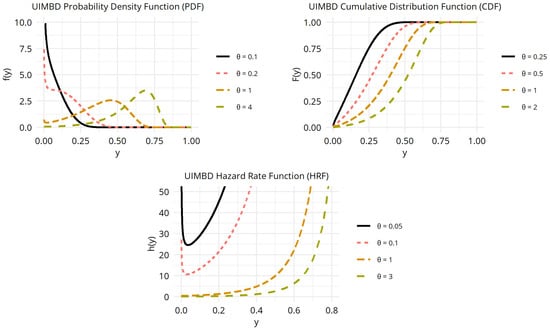
Figure 1.
Plots of the PDF (top left), CDF (top right), and HRF (bottom) of the UIMB distribution for various values.
3. Some Statistical Characteristics
This section explores key statistical properties of the UIMB distribution, providing a comprehensive analysis of its quantile function, moments, and reliability characteristics. These properties elucidate the behavior of the distribution and its applicability to modeling unit-interval data across various domains.
3.1. Quantile Function
The quantile function of the UIMB distribution facilitates random number generation and offers valuable insights into the behavior of the distribution across probability levels. For a random variable Y following a UIMB distribution with parameter , the quantile function is expressed as
Table 1 presents numerical quantile values for various values and probability levels, illustrating the adaptability of the UIMB distribution to different data scenarios. The table shows that as increases from 0.1 to 100, the quantiles shift toward higher values, reflecting a rightward shift in the mass of the distribution. This trend highlights the flexibility of UIMB distribution in modeling data with varying central tendencies within the unit interval.

Table 1.
Computed quantile values of the UIMB distribution for various values of and probability levels.
The quantile function enables random variate generation from the UIMB distribution using the inverse transform sampling method. The procedure is outlined as follows:
- (1)
- Set the scale parameter and the desired number of samples n.
- (2)
- For each to n:
- (a)
- Generate a random number .
- (b)
- Compute .
- (3)
- Return the set of random samples .
Furthermore, the UIMB distribution has transformation relationships with other distributions. Specifically, if , then . This relationship highlights the UIMB’s derivation from the InvMB distribution, extending its utility to bounded domains while preserving key probabilistic features.
3.2. Moments
The r-th moment of the random variable Y following a UIMB distribution with parameter is given by
To simplify the integral in Equation (6), we apply the substitution , which transforms the expression to
The moments in Equation (7) can be expressed analytically using the Meijer G-function, a generalized hypergeometric function useful for integrals involving exponential and power terms. Specifically, the integral can be expressed as , where is the modified Bessel function of the second kind, which is equivalent to up to constants, where
is the Meijer G-function [22]. Hence, with , , in Equation (7), we obtain that
Equation (8) provides a closed-form expression for the moments of the UIMB distribution, enabling precise computation. The first four moments (), variance, skewness, and kurtosis of the UIMB distribution are calculated for , and the results are presented in Table 2.

Table 2.
Moments for , variance, skewness, and kurtosis of the UIMB distribution for various values.
Table 2 illustrates the evolution of the statistical characteristics of the UIMB distribution as the parameter varies from 0.1 to 50. As increases, the first four moments grow steadily, shifting the mass of the distribution toward . Variance peaks near , indicating maximal dispersion, and gradually declines for larger , reflecting increasing concentration around the upper bound. Skewness values shift from strongly positive at small to negative for large , with near symmetry observed around . This trend signals a transition from right-skewed to left-skewed behavior. Similarly, kurtosis evolves from moderate leptokurtic to platykurtic around , and finally to highly leptokurtic at large , indicating the development of heavy tails. These patterns underscore the flexibility of the distribution in capturing both skewed and heavy-tailed behaviors across the unit interval.
3.3. Moment Generating Function
The moment-generating function (MGF) of a random variable Y following the UIMB distribution with parameter is defined as
Expanding allows one to express the MGF as
where the k-th moment is derived from Equation (8). Thus, the MGF can be written as
The series representation in Equation (9) enables numerical computation by truncating the series at a sufficient k, utilizing the Meijer G-function’s efficient evaluation in mathematical software such as Mathematica.
3.4. Stress–Strength Reliability
The stress–strength reliability model quantifies the probability that the strength of a system exceeds the applied stress. For the UIMB distribution, we consider as the strength and as the stress. Without loss of generality, we assume that , then the stress–strength reliability is defined as
Apply the substitution in Equation (11) to obtain
Using the normalized incomplete gamma function , where and the series expansion
in Equation (12) yields
Evaluate the inner integral in Equation (13) with , then the final form of the reliability is
3.5. Stochastic Ordering Properties
To elucidate the behavior of the UIMB distribution, we explore its stochastic ordering properties by comparing two UIMB random variables with different parameters, and , assuming without loss of generality. These properties, likelihood ratio order and hazard rate order, provide insights into the comparative behavior of random variables, particularly in reliability and risk analysis.
3.5.1. Likelihood Ratio Order
is said to be smaller than in the likelihood ratio order (denoted ) if the ratio of their PDFs, , is non-increasing in . Based on the PDF of the UIMB distribution given by Equation (1), the likelihood ratio is
where . It can be easily shown that is non-increasing in y for . Therefore, when .
3.5.2. Hazard Rate Order
if the hazard rate for all . Based on the hazard rate given by Equation (4), we obtain that
where . The overall ratio depends on the balance: for small w (large y), the exponential dominates, suggesting , while for large w (small y), the gamma ratio may dominate, suggesting . Numerically, for , , near but reverses near , indicating that the order is not universal without specific constraints.
3.6. Entropy Measures
Entropy measures quantify the uncertainty or information content of a probability distribution, providing insights into its randomness and predictability, which are valuable in applications such as reliability engineering and information theory. In this subsection, we derive the Shannon entropy for the UIMB distribution and discuss the Rényi and Tsallis entropies, which generalize the Shannon entropy for broader analytical purposes.
3.6.1. Shannon Entropy
The Shannon entropy for a continuous random variable Y with PDF is defined as
3.6.2. Rényi and Tsallis Entropies
The Rényi entropy of order (where , ) is defined as
The Tsallis entropy of order is
Both of the entropies depends on the integral , which can be expresses as
derived via the substitution . For , the term causes divergence as , so and . This reflects the behavior of the distribution near , where the PDF grows like , leading to heavy-tailed higher powers.
For , the integral converges, and using the Meijer G-function representation we obtain that
The closed-form of in Equation (18) enables computation of Renyi and Tsallis entropies for , which are given by Equations (16) and (17), respectively.
These entropy measures enhance the understanding of the information content of the UIMB distribution, with the Shannon entropy providing a precise analytical form, and the Rényi and Tsallis entropies offering Meijer G-based expressions for .
3.7. Order Statistics
Order statistics are essential in reliability engineering and quality control, where the smallest or largest values in a sample often indicate system failure points or quality thresholds. For an independent and identically distributed random sample from the UIMB distribution with parameter , the PDF of the k-th order statistic () is given by
where is the PDF from Equation (1) and is the CDF from Equation (2).
The form of the r-th moment of the k-th order statistic is complex due to the incomplete gamma function in , and the corresponding integral does not yield a closed-form expression in terms of elementary or standard special functions. Numerical evaluation can be performed via quadrature methods or Monte Carlo simulation, where samples are generated using the quantile function from Equation (5) and ordered to compute the moments. In reliability applications, these moments are useful for estimating expected failure times, such as for the minimum lifetime in parallel systems or for the maximum lifetime in series systems.
4. Estimation Methods
This section examines various classical approaches for estimating the scale parameter of the UIMB distribution. Given a random sample from the UIMB distribution with scale parameter , we investigate maximum likelihood estimation (MLE), Anderson–Darling (AD), maximum product spacing (MPS), ordinary least-squares (OLS), weighted least-squares (WLS), and Cramér-von Mises (CVM) methods. These methods provide reliable parameter estimation for unit-interval data, with numerical optimization often necessitated by the nonlinear nature of the incomplete gamma function within the structure of the UIMB distribution.
4.1. Maximum Likelihood Estimation
The maximum likelihood estimator (MLE) for is obtained by maximizing the log-likelihood function
Differentiating Equation (19) with respect to , we get
The closed-form solution for the MLE is
To establish the existence and uniqueness of the MLE, consider the second derivative of the log-likelihood function
The second derivative in Equation (22) is negative when , or equivalently, when . Given that the first derivative is positive for small and negative for large , and the log-likelihood is concave in the relevant region, the MLE exists and is unique, as confirmed by the explicit solution in Equation (21).
4.2. Anderson–Darling Methods
This approach employs minimum distance estimators to optimize parameter fit based on the observed data. For an ordered random sample , we consider three AD-based estimators: the Anderson–Darling Estimator (ADE), Right-Tail Anderson–Darling Estimator (RTADE), and Left-Tail Anderson–Darling Estimator (LTADE). The objective functions are defined as follows:
The ADE minimizes
Differentiating the function in Equation (23) with respect to ,
where and are the CDF (2) and SF (3) of the UIMB distribution with parameter , respectively. The RTADE focuses on the right tail, minimizing
4.3. Maximum Product Spacing
Th maximum product spacing method estimates by maximizing the geometric mean of spacings derived from the observed data. For an ordered random sample , the spacings are defined as
where , , , and . The MPS objective is
Differentiating the function in Equation (26) with respect to , we obtain
4.4. Ordinary and Weighted Least-Squares
The OLS and WLS methods estimate by minimizing the squared differences between the theoretical distribution and the empirical distribution based on the observed data. The objective functions are defined as follows:
4.5. Cramér–von Mises
The Cramér–von Mises method minimizes the weighted squared difference between the theoretical distribution and the empirical distribution based on the observed data. he objective is
where is the empirical CDF.
5. Simulation Settings and Results
This section performs simulation analyses to evaluate the performance of various estimation methods for the scale parameter of the UIMB distribution across diverse sample sizes and parameter values. The assessment focuses on bias, mean squared error (MSE), mean absolute deviation (MAD), mean relative error (MRE), and standard deviation (SD) of the estimators, providing a comprehensive measure of accuracy and precision. The methods under consideration include MLE, ADEs, RTADEs, LTADEs, OLS, WLS, MPS, and CVM. Simulations are conducted for values of 0.2, 0.5, 2, and 5 to explore a wider range of parameter settings, reflecting the applicability of the UIMB distribution to unit-interval data.
A total of 1000 random samples are generated with sizes and 500 from the UIMB distribution for each value under two scenarios: a normal scenario with data generated solely from the UIMB distribution, and an outliers scenario where 5% of the data is replaced with uniform random values in (0, 1) to test robustness. These simulations are implemented using the R programming environment [23]. The performance of the estimation methods is evaluated using several statistical metrics. Bias is defined as the average deviation of the estimated parameter from the true parameter , mathematically expressed as , where represents the number of simulations. MSE, a measure of overall estimation accuracy, is given by . MAD quantifies the average absolute error, formulated as . MRE assesses the relative deviation, defined as . The SD of the estimates across the 1000 samples, reflecting estimation variability, is computed as the sample standard deviation of . These metrics collectively enable a thorough assessment of the estimator performance of the UIMB distribution across varying sample sizes and parameter values.
The results are summarized in Table 3, Table 4, Table 5, Table 6, Table 7, Table 8, Table 9 and Table 10 for and 5 under normal and outliers scenarios, respectively. In the normal scenario, all estimation methods exhibit consistency, with bias, MSE, MAD, MRE, and SD decreasing as sample size increases, aligning with asymptotic theory. For , MLE achieves the lowest MSE and near-zero bias, indicating superior accuracy. ADE and WLS show comparable performance at smaller sample sizes, with reduced bias relative to other methods. At , MLE maintains a low MSE, while ADE and WLS remain competitive. For , MLE exhibits low MSE and decreasing bias, outperforming MPS. At , MLE starts with a notable bias but improves significantly, with MSE decreasing from 0.1693 to 0.0324. CVM and LTADE exhibit higher variability, particularly at smaller sample sizes.

Table 3.
Simulation results under normal conditions for .

Table 4.
Simulation results under outlier conditions for .

Table 5.
Simulation results under normal conditions for .

Table 6.
Simulation results under outlier conditions for .

Table 7.
Simulation results under normal conditions for .

Table 8.
Simulation results under outlier conditions for .

Table 9.
Simulation results under normal conditions for .

Table 10.
Simulation results under outlier conditions for .
In the outliers scenario, the presence of 5% uniform random values introduces significant challenges. For and , methods like ADE, LTADE, and RTADE show an increasing trend in MSE and bias as n increases, reflecting the cumulative impact of outliers. MLE demonstrates relative stability, with MSE fluctuating but remaining lower. For , a U-shaped trend is observed, where MSE initially decreases but then increases, indicating a transitional effect of outliers. For , MSE generally decreases with n, suggesting improved resilience at larger sample sizes.
Graphical representations of these outcomes are provided in Figure 2, Figure 3, Figure 4, Figure 5, Figure 6, Figure 7, Figure 8 and Figure 9, illustrating trends in Bias squared, MSE, MAD, and MRE as functions of sample size for each value under both scenarios. In the normal scenario, MLE consistently achieves the smallest bias and MSE, with values decreasing as n increases, confirming its robustness. In the outliers scenario, MLE and CVM show better resilience compared to ADE, LTADE, and MPS, where bias and MSE often increase or have a fluctuated pattern. The increasing trend for and , U-shaped trend for , and decreasing trend for in the outliers scenario highlight the varying impact of outliers across parameter values, with MLE demonstrating superior adaptability at higher values.
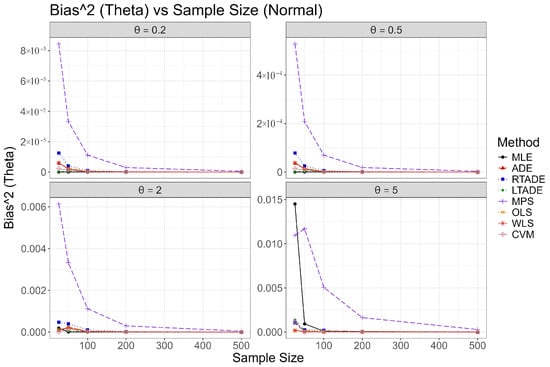
Figure 2.
Plots of bias squared for the UIMB distribution across sample sizes for various values in the normal scenario.
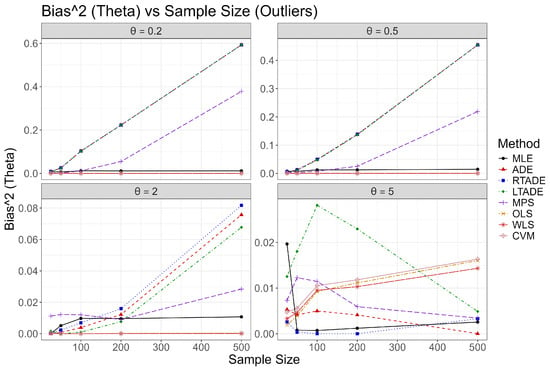
Figure 3.
Plots of bias squared for the UIMB distribution across sample sizes for various values in the outlier scenario.
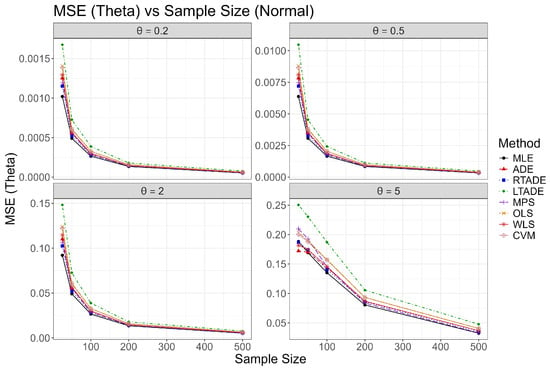
Figure 4.
Plots of MSE for the UIMB distribution across sample sizes for various values in the normal scenario.
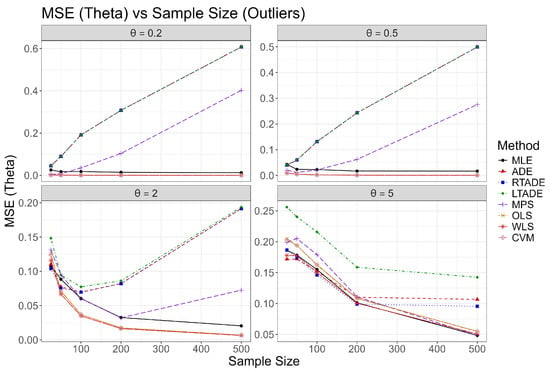
Figure 5.
Plots of MSE for the UIMB distribution across sample sizes for various values in the outlier scenario.
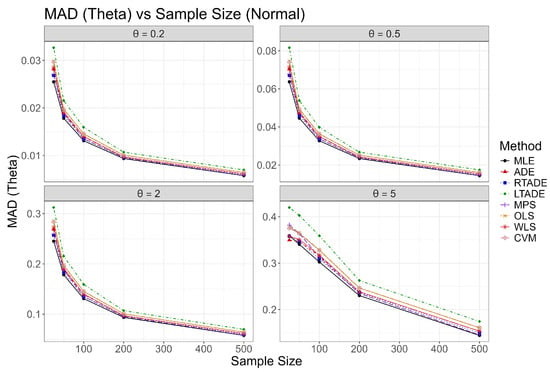
Figure 6.
Plots of MAD for the UIMB distribution across sample sizes for various values in the normal scenario.
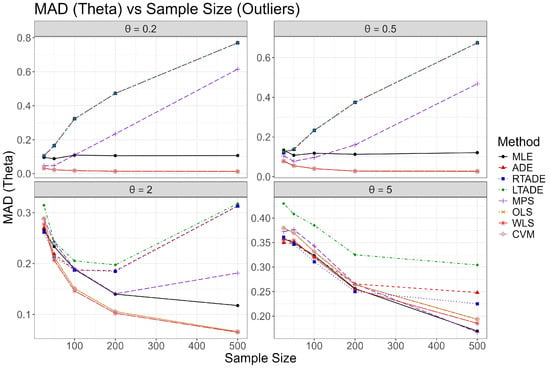
Figure 7.
Plots of MAD for the UIMB distribution across sample sizes for various values in the outlier scenario.
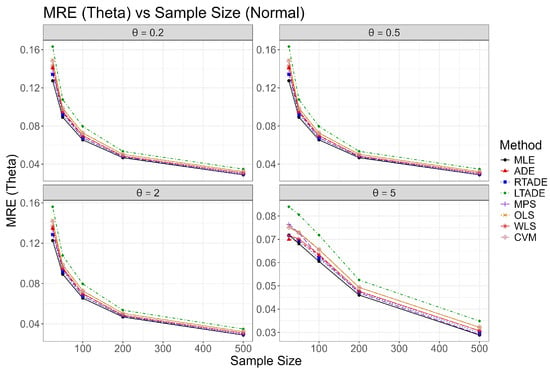
Figure 8.
Plots of MRE for the UIMB distribution across sample sizes for various values in the normal scenario.
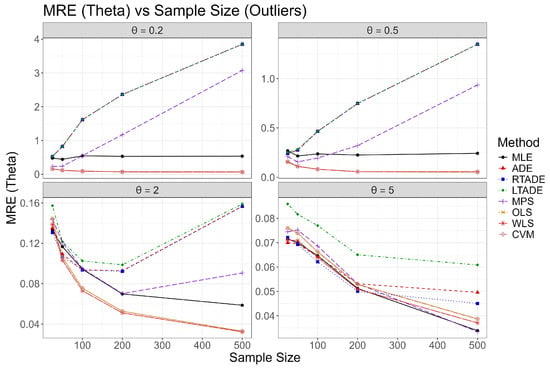
Figure 9.
Plots of MRE for the UIMB distribution across sample sizes for various values in the outliers scenario.
These simulation analyses validate the efficacy of the proposed estimation methods, with MLE emerging as the most reliable across varying values and sample sizes in the normal scenario. The outliers scenario reveals that the MLE and CVM demonstrate better robustness compared to other methods.
6. Real Data Applications
This section evaluates the efficacy of the UIMB distribution in modeling three real datasets, referred to as Dataset 1, Dataset 2, and Dataset 3, to demonstrate its suitability for unit-interval data in manufacturing and mining applications. Dataset 1 consists of 50 observations with a hole diameter of 12 mm and a sheet thickness of 3.15 mm, while Dataset 2 comprises 50 observations with a hole diameter of 9 mm and a sheet thickness of 2 mm. Hole diameter readings are taken with respect to one fixed hole, selected as per a predetermined orientation, and the datasets relate to two different machines under comparison. Further details on the measurement process are provided in [24]. These datasets have also been analyzed by [25,26,27,28,29]. Dataset 3 is the Rubidium concentration dataset, which is sourced from mining engineering data [30] and normalized by dividing the original concentrations by 1000 to ensure unit-interval support. The numerical values for Dataset 1 and Dataset 2 are presented in Table 11.

Table 11.
Hole Diameter Measurements for Manufacturing Datasets 1 and 2.
The numerical values of Dataset 3 are available in [30]. Comparisons are conducted with the Unit Maxwell–Boltzmann (UMB), Unit Topp–Leone (UTL), Unit Lindley (ULL), and Unit Log-Weighted Exponential (ULWE) distributions using maximum likelihood estimation implemented in R software [23]. The model selection criteria, integrated into the fit analysis, are defined as follows: the Akaike Information Criterion (AIC) is , where is the log-likelihood function and k is the number of parameters; the Corrected Akaike Information Criterion (AICc) is , with n as the sample size; the Bayesian Information Criterion (BIC) is ; and the Hannan-Quinn Information Criterion (HQIC) is . These criteria balance model fit and complexity, with lower values indicating a superior fit.
Dataset 1 exhibits a mean of 0.1632, a median of 0.1600, and a standard deviation of 0.0811, with minimal skewness and negative kurtosis, indicating a slightly right-skewed distribution with lighter tails, as given in Table 12. Fit results from Table 13 demonstrate that the UIMB distribution markedly outperforms other models, achieving the lowest values for (−101.83), AIC (−99.83), AICc (−99.75), BIC (−97.92), and HQIC (−97.10), alongside Cramér–von Mises statistic () (0.14, ) and Kolmogorov–Smirnov statistic (KS) (0.12, ). The UMB distribution performs competitively but is less effective, while the UTL, ULL, and ULWE distributions yield significantly higher test statistics, underscoring the superior fit of the UIMB distribution. The top-left panel of Figure 10 provides visual confirmation, with the histogram of the UIMB distribution closely aligning with the burr measurements in Dataset 1.

Table 12.
Descriptive statistics of Dataset 1.

Table 13.
Parameter estimation and fit evaluation for Dataset 1.
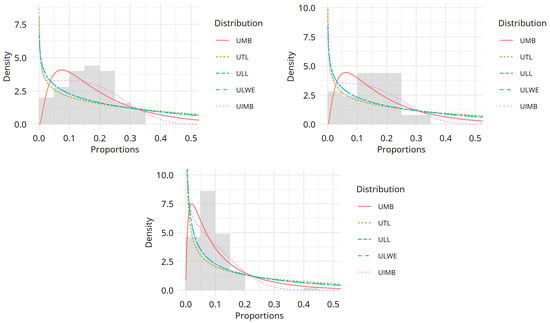
Figure 10.
Fitted density histograms for Dataset 1, Dataset 2, and Dataset 3.
Dataset 2 displays a mean of 0.1520, a median of 0.1600, and a standard deviation of 0.0785, with a small skewness and negative kurtosis, reflecting a nearly symmetric distribution with lighter tails, as presented in Table 14. Fit results from Table 15 reveal that the UIMB distribution substantially outperforms other models, attaining the best (−106.22), AIC (−104.22), AICc (−104.14), BIC (−102.31), and HQIC (−101.49), with (0.20, ) and KS (0.15, ). The UMB distribution performs competitively but is less effective, while the UTL, ULL, and ULWE distributions exhibit significantly higher test statistics, reinforcing the superiority of the UIMB distribution. The top-right panel of Figure 10 corroborates this, with the histogram of the UIMB distribution effectively capturing the burr measurements in Dataset 2.

Table 14.
Descriptive statistics of Dataset 2.

Table 15.
Parameter estimation and fit evaluation for Dataset 2.
Dataset 3 exhibits a mean of 0.0886, a median of 0.0840, and a standard deviation of 0.0555, with high skewness and kurtosis, indicating a right-skewed distribution with heavy tails, as given in Table 16. Fit results from Table 17 reveal that the UIMB distribution substantially outperforms other models, attaining the best (−241.27), AIC (−239.27), AICc (−239.22), BIC (−236.81), and HQIC (−236.28), with (0.65, ) and KS (0.15, ). The bottom panel of Figure 10 corroborates this, with the histogram of the UIMB distribution effectively capturing the Rubidium concentrations.

Table 16.
Descriptive statistics of Dataset 3.

Table 17.
Parameter estimation and fit evaluation for Dataset 3.
The UIMB distribution demonstrates superior fitting capabilities for these datasets, leveraging its adaptable density shapes to capture the nuances of unit-interval data. Its performance surpasses that of the UMB, UTL, ULL, and ULWE distributions, as evidenced by consistently lower information criteria and superior goodness-of-fit statistics. These findings highlight the substantial potential of the UIMB distribution in reliability engineering and mining studies.
7. Conclusions
This study introduced the UIMB distribution, a novel single-parameter model tailored for unit-interval data, derived through an exponential transformation of the InvMB distribution. The UIMB distribution addresses the limitations of traditional models by offering flexible density shapes and hazard rate behaviors, including right-skewed, left-skewed, unimodal, and bathtub-shaped patterns, making it highly adaptable for applications in reliability engineering and environmental science. Its statistical properties, including moments, quantiles, survival, and hazard functions, along with stochastic ordering, entropy measures, and the moment-generating function, were thoroughly derived, demonstrating its capacity to capture complex data patterns within the () interval.
Simulation studies validated the robustness of various estimation methods for the scale parameter of the UIMB distribution in terms of bias, mean squared error, and mean absolute deviation across diverse sample sizes and parameter values. The inclusion of normal and outlier scenarios highlighted the adaptability of the model to skewed and contaminated data, with MLE exhibiting superior stability and resilience.
Real-data applications on two manufacturing datasets and a Rubidium concentration dataset underscored the superior fit of the UIMB distribution compared to competing models like the Unit Maxwell–Boltzmann, Unit Topp–Leone, Unit Lindley, and Unit Log-Weighted Exponential distributions. The UIMB distribution achieved the lowest values for information criteria, effectively capturing the right-skewed nature of burr measurements on iron sheets and normalized concentrations. Visual and statistical evidence confirmed its precision in modeling unit-interval phenomena.
The single-parameter design of the UIMB distribution balances computational efficiency with modeling flexibility, offering a practical tool for practitioners. Future research could explore extensions of the UIMB distribution, such as incorporating censored data models, developing Bayesian estimation approaches, or applying the model to other domains like financial ratios or biological proportions.
These findings establish the UIMB distribution as a robust and versatile addition to the statistical modeling toolkit for unit-interval data.
Author Contributions
Conceptualization, M.G. and Ö.Ö.; methodology, M.G. and Ö.Ö.; software, M.G.; validation, Ö.Ö.; formal analysis, M.G.; investigation, M.G. and Ö.Ö.; resources, M.G.; data curation, Ö.Ö.; writing—original draft preparation, M.G. and Ö.Ö.; writing—review and editing, M.G. and Ö.Ö.; visualization, M.G.; supervision, Ö.Ö. All authors have read and agreed to the published version of the manuscript.
Funding
This research received no external funding. The APC was funded by the authors.
Data Availability Statement
The real datasets used in this study are fully provided in Section 6 of the manuscript, sourced from Dasgupta (2011) [Dasgupta, R., (2011). On the distribution of burr with applications. Sankhya B, 73(1):1–19.]. The simulation data can be reproduced using the settings described in Section 5, and the simulation code is available upon request from the corresponding author.
Conflicts of Interest
The authors declare no conflicts of interest.
References
- Bayes, T. An Essay Towards Solving a Problem in the Doctrine of Chances. Philos. Trans. R. Soc. 1763, 53, 370–418. [Google Scholar] [CrossRef]
- Topp, C.W.; Leone, F.C. A Family of J-Shaped Frequency Functions. J. Am. Stat. Assoc. 1955, 50, 209–219. [Google Scholar] [CrossRef]
- Johnson, N.L.; Kotz, S.; Balakrishnan, N. Continuous Univariate Distributions, Volume 2, 2nd ed.; Wiley: Hoboken, NJ, USA, 1995. [Google Scholar]
- Mazucheli, J.; Menezes, A.F.; Dey, S. Unit-Gompertz Distribution with Applications. Statistica 2019, 79, 25–43. [Google Scholar] [CrossRef]
- Mazucheli, J.; Menezes, A.F.B.; Chakraborty, S. On the One Parameter Unit-Lindley Distribution and Its Associated Regression Model for Proportion Data. J. Appl. Stat. 2019, 46, 700–714. [Google Scholar] [CrossRef]
- Smithson, M.; Shou, Y. CDF-Quantile Distributions for Modelling RVs on the Unit Interval. Br. J. Math. Stat. Psychol. 2017, 70, 412–438. [Google Scholar] [CrossRef]
- Maxwell, J.C. On the dynamical theory of gases. Philos. Trans. R. Soc. Lond. 1867, 157, 49–88. [Google Scholar] [CrossRef]
- Bekker, A.; Roux, J. Reliability characteristics of the Maxwell distribution: A Bayes estimation study. Commun. Stat.-Theory Methods 2005, 34, 2169–2178. [Google Scholar] [CrossRef]
- Chaturvedi, A.; Rani, U. Classical and Bayesian reliability estimation of the generalized Maxwell failure distribution. J. Stat. Res. 1998, 32, 113–120. [Google Scholar]
- Tyagi, R.; Bhattacharya, S. Bayes estimation of the Maxwell’s velocity distribution function. Statistica 1989, 29, 563–567. [Google Scholar]
- Biçer, C.; Bakouch, H.S.; Biçer, H.D.; Alomair, G.; Hussain, T.; Almohisen, A. Unit Maxwell-Boltzmann Distribution and Its Application to Concentrations Pollutant Data. Axioms 2024, 13, 226. [Google Scholar] [CrossRef]
- Slezakova, K.; Castro, D.; Pereira, M.C.; Morais, S.; Delerue-Matos, C.; Alvim-Ferraz, M.C. Influence of traffic emissions on the carcinogenic polycyclic aromatic hydrocarbons in outdoor breathable particles. J. Air Waste Manag. Assoc. 2010, 60, 393–401. [Google Scholar] [CrossRef]
- Sharma, V.K.; Singh, S.K.; Singh, U. A new upside-down bathtub shaped hazard rate model for survival data analysis. Appl. Math. Comput. 2014, 239, 242–253. [Google Scholar] [CrossRef]
- Tomer, S.K.; Panwar, M.S. A Review on Inverse Maxwell Distribution with Its Statistical Properties and Applications. J. Stat. Theory Pract. 2020, 14, 33. [Google Scholar] [CrossRef]
- Singh, K.L.; Srivastava, R.S. Inverse Maxwell distribution as a survival model, genesis and parameter estimation. Res. J. Math. Stat. Sci. 2014, 2, 23–28. [Google Scholar]
- Bjerkedal, T. Acquisition of resistance in guinea pigs infected with different doses of virulent tubercle bacilli. Am. J. Hyg. 1960, 72, 130–148. [Google Scholar]
- Veriables, W.N.; Ripley, B.D. Modern Applied Statistics with S, 4th ed.; Springer: Berlin/Heidelberg, Germany, 2002. [Google Scholar] [CrossRef]
- Sharma, V.K.; Singh, S.K.; Singh, U.; Agiwal, V. The inverse Lindley distribution: A stress-strength reliability model with application to head and neck cancer data. J. Ind. Prod. Eng. 2015, 32, 163–173. [Google Scholar] [CrossRef]
- Castillo, J.S.; Goette, K.P.; Muñoz, H.A.; Gallardo, D.I.; Bourguignon, M.; Venegas, O.; Gómez, H.M. A New Generalized Gamma Generated Family of Distributions with Applications. Mathematics 2023, 11, 529. [Google Scholar] [CrossRef]
- Eaton, M.L. Group Invariance Applications in Statistics; Institute of Mathematical Statistics: Beachwood, OH, USA, 1989. [Google Scholar]
- Alzaatreh, A.; Famoye, F.; Lee, C. A new method for generating families of continuous distributions. Metron 2013, 71, 63–79. [Google Scholar] [CrossRef]
- Gradshteyn, I.S.; Ryzhik, I.M. Table of Integrals, Series, and Products, 7th ed.; Academic Press: Amsterdam, The Netherlands, 2007. [Google Scholar]
- R Core Team. R: A Language and Environment for Statistical Computing, Version 4.4.3; R Foundation for Statistical Computing: Vienna, Austria, 2025.
- Dasgupta, R. On the distribution of burr with applications. Sankhya B 2011, 73, 1–19. [Google Scholar] [CrossRef]
- Korkmaz, M.c.; Erişoglu, M. The Burr XII-geometric distribution. J. Selçuk Univ. Nat. Appl. Sci. 2014, 3, 75–87. [Google Scholar]
- Dey, S.; Mazucheli, J.; Anis, M. Estimation of reliability of multicomponent stress-strength for a kumaraswamy distribution. Commun.-Stat.-Theory Methods 2017, 46, 1560–1572. [Google Scholar] [CrossRef]
- Dey, S.; Mazucheli, J.; Nadarajah, S. Kumaraswamy distribution: Different methods of estimation. Comput. Appl. Math. 2018, 37, 2094–2111. [Google Scholar] [CrossRef]
- ZeinEldin, R.A.; Chesneau, C.; Jamal, F.; Elgarhy, M. Different estimation methods for type I half-logistic Topp-Leone distribution. Mathematics 2019, 7, 985. [Google Scholar] [CrossRef]
- Gündüz, S.; Korkmaz, M.c. A New Unit Distribution Based on the Unbounded Johnson Distribution Rule: The Unit Johnson SU Distribution. Pak. J. Stat. Oper. Res. 2020, 16, 471–490. [Google Scholar] [CrossRef]
- Reyes, J.; Rojas, M.A.; Venegas, O.; Gómez, H.W. Nakagami distribution with heavy tails and applications to mining engineering data. J. Stat. Theory Pract. 2020, 14, 55. [Google Scholar] [CrossRef]
Disclaimer/Publisher’s Note: The statements, opinions and data contained in all publications are solely those of the individual author(s) and contributor(s) and not of MDPI and/or the editor(s). MDPI and/or the editor(s) disclaim responsibility for any injury to people or property resulting from any ideas, methods, instructions or products referred to in the content. |
© 2025 by the authors. Licensee MDPI, Basel, Switzerland. This article is an open access article distributed under the terms and conditions of the Creative Commons Attribution (CC BY) license (https://creativecommons.org/licenses/by/4.0/).